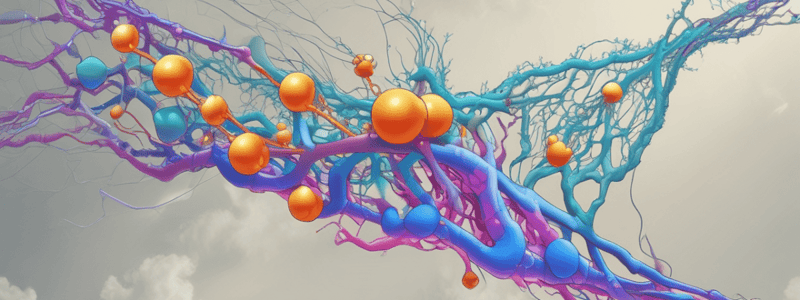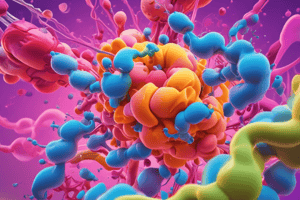Podcast
Questions and Answers
What is the primary mechanism of action of COMT inhibitors in the management of Parkinson's disease?
What is the primary mechanism of action of COMT inhibitors in the management of Parkinson's disease?
- Inhibition of voltage-activated Na+ channels
- Enhancement of GABA-mediated synaptic inhibition
- Antagonism of AMPA or NMDA receptors
- Inhibition of Catechol-O-methyl transferase (COMT) (correct)
Which of the following acetylcholine receptor antagonists is known to have favorable effects on rigidity and bradykinesia?
Which of the following acetylcholine receptor antagonists is known to have favorable effects on rigidity and bradykinesia?
- Entacapone
- Trihexyphenidyl
- Tolcapone
- Benztropine (correct)
What is a significant adverse effect of tolcapone that requires close monitoring?
What is a significant adverse effect of tolcapone that requires close monitoring?
- Diarrhea
- Brown-orange urine discoloration
- Hepatotoxicity (correct)
- Orthostatic hypotension
Which anti-epileptic drug has a mechanism of action involving the inhibition of voltage-activated Na+ channels?
Which anti-epileptic drug has a mechanism of action involving the inhibition of voltage-activated Na+ channels?
What is the primary reason for adjusting total phenytoin levels?
What is the primary reason for adjusting total phenytoin levels?
Which of the following is a significant interaction of SSRIs?
Which of the following is a significant interaction of SSRIs?
What is a common adverse effect of acetylcholine receptor antagonists?
What is a common adverse effect of acetylcholine receptor antagonists?
What is the target concentration of free phenytoin in the blood after 5 days of dosing?
What is the target concentration of free phenytoin in the blood after 5 days of dosing?
Which COMT inhibitor is combined with levodopa/carbidopa in the medication Stalevo?
Which COMT inhibitor is combined with levodopa/carbidopa in the medication Stalevo?
What is the primary mechanism of action of SSRIs?
What is the primary mechanism of action of SSRIs?
What is the primary function of Acetylcholinesterase in the body?
What is the primary function of Acetylcholinesterase in the body?
What is the mechanism of action of Memantine?
What is the mechanism of action of Memantine?
What is the primary advantage of using Rytary over Sinemet CR?
What is the primary advantage of using Rytary over Sinemet CR?
What is the primary function of Carbidopa?
What is the primary function of Carbidopa?
What is the primary reason for combining Levodopa with Carbidopa?
What is the primary reason for combining Levodopa with Carbidopa?
What is the primary advantage of using Acetylcholinesterase Inhibitors in the treatment of Alzheimer's disease?
What is the primary advantage of using Acetylcholinesterase Inhibitors in the treatment of Alzheimer's disease?
What is the primary reason for the wearing off phenomenon of Levodopa?
What is the primary reason for the wearing off phenomenon of Levodopa?
What is the primary difference between Donepezil and Galantamine?
What is the primary difference between Donepezil and Galantamine?
What is the primary mechanism of action of Rivastigmine?
What is the primary mechanism of action of Rivastigmine?
What is the primary adverse effect of Memantine?
What is the primary adverse effect of Memantine?
What is the frequency of administration for IM available antipsychotics?
What is the frequency of administration for IM available antipsychotics?
Which of the following antipsychotics is associated with a higher risk of agranulocytosis?
Which of the following antipsychotics is associated with a higher risk of agranulocytosis?
What is the primary reason for monitoring A1C periodically in patients treated with atypical antipsychotics?
What is the primary reason for monitoring A1C periodically in patients treated with atypical antipsychotics?
Which of the following antipsychotics is approved for the treatment of agitation associated with dementia due to Alzheimer's disease?
Which of the following antipsychotics is approved for the treatment of agitation associated with dementia due to Alzheimer's disease?
What is a common neurological side effect of antipsychotics?
What is a common neurological side effect of antipsychotics?
Which of the following antipsychotics is known to cause the most weight gain?
Which of the following antipsychotics is known to cause the most weight gain?
What is a characteristic of newer second-generation antipsychotics, such as Brexpiprazole and Cariprazine?
What is a characteristic of newer second-generation antipsychotics, such as Brexpiprazole and Cariprazine?
Which of the following antipsychotics can be used for the treatment of bipolar disorder?
Which of the following antipsychotics can be used for the treatment of bipolar disorder?
What is a common cardiovascular side effect of antipsychotics?
What is a common cardiovascular side effect of antipsychotics?
What is the primary reason for continuing PO treatment during the first 3 weeks when transitioning to IM antipsychotics?
What is the primary reason for continuing PO treatment during the first 3 weeks when transitioning to IM antipsychotics?
What should be done when switching from a SSRI to a MAOI?
What should be done when switching from a SSRI to a MAOI?
What is the mechanism of action of bupropion?
What is the mechanism of action of bupropion?
What is the most significant adverse effect of brexanolone?
What is the most significant adverse effect of brexanolone?
What is the term for the symptoms of schizophrenia that are not present in normal individuals?
What is the term for the symptoms of schizophrenia that are not present in normal individuals?
What is the mechanism of action of typical antipsychotics?
What is the mechanism of action of typical antipsychotics?
What is the term for the symptoms of schizophrenia that are present in normal individuals but are diminished in schizophrenia?
What is the term for the symptoms of schizophrenia that are present in normal individuals but are diminished in schizophrenia?
What is the drug that is chemically identical to allopregnanolone and is used to treat post-partum depression?
What is the drug that is chemically identical to allopregnanolone and is used to treat post-partum depression?
What is the time frame for improvement in hallucinations and disturbances with antipsychotic treatment?
What is the time frame for improvement in hallucinations and disturbances with antipsychotic treatment?
What is the mechanism of action of aripiprazole?
What is the mechanism of action of aripiprazole?
What is the SSRI that is least likely to cross into breast milk?
What is the SSRI that is least likely to cross into breast milk?
Flashcards are hidden until you start studying
Study Notes
Enzymes
- Enzymes typically end in –ASE
- Acetylcholinesterase (AChE) is responsible for hydrolyzing Acetylcholine (ACh) and decreases the amount of ACh
Acetylcholinesterase Inhibitors
- Selectively inhibit cholinesterase in the CNS
- Increase Ach concentrations in the cerebral cortex
- May slow deterioration of cognitive function and preserve memory, learning, and attention
- Examples of agents: Donepezil (Aricept), Rivastigmine (Exelon), Galantamine (Razadyne)
- Adverse effects: Memantine (Namenda) - constipation, headache, confusion, dizziness, hallucinations, hypertension
Levodopa
- Biosynthetic precursor of dopamine
- Increases the concentration of dopamine in the brain
- Metabolized in peripheral tissue by Decarboxylase and Catechol-O-methyl transferase (COMT)
- Adverse effects: nausea, vomiting, orthostatic hypotension, sedation, depression, delirium, paranoia, delusions, hallucinations
- Always given in combination with carbidopa (Sinemet, Sinemet CR, Parcopa)
Carbidopa
- MOA: Decarboxylase Inhibitor
- Inhibits conversion of levodopa to dopamine in peripheral tissues
- Increases the amount of levodopa that enters the brain
- Decreases GI and cardiovascular adverse effects due to less conversion in peripheral tissue
COMT Inhibitors
- Inhibits peripheral metabolism of levodopa through inhibition of Catechol-O-methyl transferase (COMT)
- Used in combination with levodopa/carbidopa to enhance its effectiveness and manage wearing off
- Examples of agents: Tolcapone, Entacapone, Opicapone
- Adverse effects: Hepatotoxicity (tolcapone), orthostatic hypotension, diarrhea, hallucinations, brown-orange urine discoloration (benign)
Acetylcholine Receptor Antagonists
- Mechanism of action: Competes with Ach at muscarinic receptors (anticholinergic)
- Helps reduce tremor
- Adverse effects: sedation, depression, confusion, dry mouth, blurred vision, constipation, urinary retention
Antiepileptic Drugs
- Four primary mechanisms: Inhibit voltage-activated Na+ channels, inhibit voltage-activated Ca2+ channels, enhance GABA-mediated synaptic inhibition, and attenuate Glutamate-mediated excitatory responses
- Examples of agents: Phenytoin (Dilantin), Phenytoin Pharmacokinetics - half-life ~ 24 hours, highly protein bound, metabolized by the liver, dose-dependent (Michaelis-Mentin also known as non-linear kinetics)
SSRIs
- Adverse effects: cardiovascular (QT prolongation with citalopram and escitalopram), withdrawal syndrome (GI complaints, flu-like symptoms, anxiety, insomnia)
- Drug interactions: MAOIs, TCAs, SNRIs, 5HT over-the-counter supplements
- Examples of agents: Bupropion (Wellbutrin), Venlafaxine (Effexor), Desvenlafaxine (Pristiq), Duloxetine (Cymbalta), Milnacipran (Savella)
SNRIs
- Bind to serotonin (SERT) and norepinephrine (NET) transporters
- Prevent reuptake of both 5HT and NE (selective for NE)
- Adverse effects: hypertension, sexual dysfunction, insomnia, nausea
Depression in Pregnancy
- Reported in 14 to 23% of pregnant patients
- Mild to moderate depression: Discontinue pharmacotherapy unless severe history, Cognitive behavioral therapy/interpersonal psychotherapy
- Severe depression: Initiate/continue pharmacotherapy, Sertraline (least likely to cross into breast milk)
Brexanolone (Zulresso)
- Post-partum depression
- MOA: Allosteric modulator of GABAa
- Chemically identical to allopregnanolone
- Restores dysregulated neural network activity associated with depression
- One-time 60-hour infusion
- Adverse effects: sedation/loss of consciousness (dose-related), start in AM to best assess degree of sedation
Schizophrenia
- Positive (+) symptoms: delusions, hallucinations, disorganized speech, unusual behavior, hostility, excitement, grandiosity
- Negative (-) symptoms: blunted affect, lack of motivation and pleasure, emotional withdrawal, uncooperativeness, social withdrawal, poverty of speech
- Antipsychotic class: Dopamine (D2) receptor blockers, Serotonin (5-HT2) receptor agonist/antagonist
- Typical antipsychotics: Phenothiazines (Chlorpromazine, Fluphenazine, Thioridazine, Perphenazine, Trifluoperazine), Thioxanthenes (Thiothixene), Butyrophenones (Haloperidol)
- Atypical antipsychotics: Clozapine (Clozaril), Loxapine (Loxitane), Olanzapine (Zyprexa), Quetiapine (Seroquel), Ziprasidone (Geodon), Aripiprazole (Abilify), Aristada (IM), Asenapine (Saphris), Iloperidone (Fanapt), Lurasidone (Latuda), Risperidone (Risperdal), Paliperidone (Invega)
- Adverse effects: weight gain, impaired glucose tolerance, clear risk of diabetes mellitus, sexual dysfunction, hematologic (clozapine may cause agranulocytosis)
Newer Second Generation Antipsychotics
- Brexpiprazole (Rexulti)
- Cariprazine (Vraylar)
- Both have complex (theoretically better targeted) mechanisms of action (sub-receptors)
- Similar side effect profile to Aripiprazole
- Brexpiprazole: slightly more weight gain seen in MDD studies but less EPS symptoms
Studying That Suits You
Use AI to generate personalized quizzes and flashcards to suit your learning preferences.





